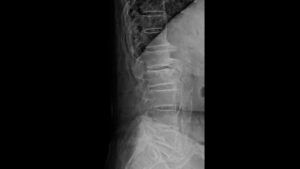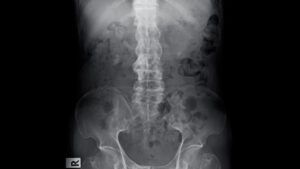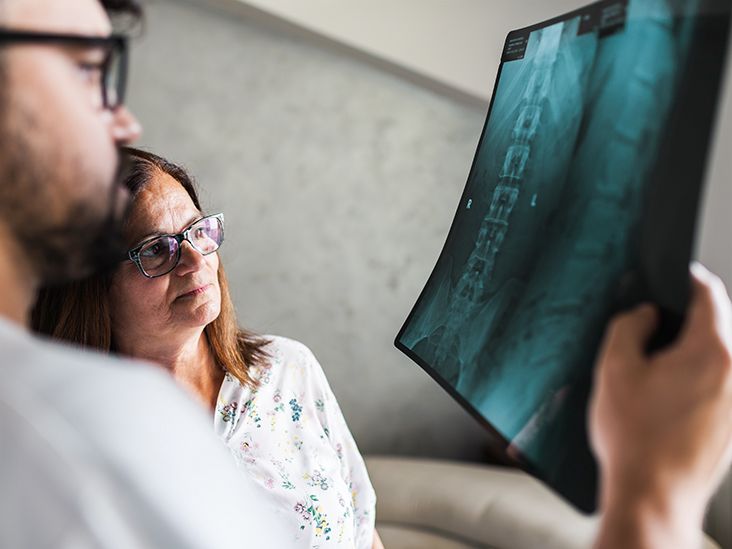Ankylosing spondylitis primarily affects the joints in your spine. Medical imaging can help us see some of the inflammation and damage and how they lead to symptoms.
Ankylosing spondylitis (AS) is a type of arthritis that causes inflammation of the joints of your spine, resulting in pain. AS often affects the sacroiliac (SI) joints, where the base of your spine and pelvis meet.
The exact cause of AS is







Sacroiliitis
The most common symptom of AS is sacroiliitis. The SI joints are located at your spine’s base, where it connects to your pelvis. When inflamed, they cause pain in your lower back and buttocks.
This can even cause pain in your legs, which can worsen if you stand for an extended period. If a doctor suspects AS, they will likely check for sacroiliitis.
Hunched over
When AS is severe, the vertebrae of your spine can grow together and fuse. The fused bones may force your spine into a forward curve. This is called kyphosis.
As your spine curves, your back curls into a stooped-over position.
People with severe AS who have not received treatment may be so bent over that they have trouble even lifting their head. However, advances in treatment have made kyphosis less common.
Pain and stiffness
AS affects your spine, but it can also cause pain and stiffness in other parts of your body, including your:
- hips
- lower back
- neck
- shoulders
Pain and other symptoms of AS start slowly.
In fact, you may not notice them at first. But they can get worse over time, and the pain may come and go. Or you may be in constant pain. Some people notice stiffness more in the morning when they wake up.
Fractures
Osteoporosis may
If the fractures are in your spine, the vertebrae may collapse and cause your back to bend forward even more than it already does. Some fractures can even compress nerves in your spine.
Painful eyes
One of the most common features of AS involves inflammation of your eyes. This inflammatory eye condition is called uveitis. Your eyes can swell up, which may cause:
- pain
- blurred vision
- sensitivity to bright light
- red, watery eyes
Uveitis is a serious complication of AS. If your eyes start to bother you, call a doctor for an appointment right away.
Trouble breathing
When you breathe, your lungs expand. The rib cage that houses and protects your lungs also expands slightly. If the joints of your ribs are inflamed from AS, their movement may be restricted.
You may feel pain when you breathe. And you probably won’t be able to inflate your lungs all the way. This will make it hard for you to catch your breath and may increase your risk of lung infections.
Fatigue
Fatigue is one of the most significant factors affecting people with AS. It takes a lot of energy for your body to manage the inflammation AS causes.
Also, the pain of AS can make it hard for you to sleep. Some people with AS have anemia, meaning they have too few of the blood cells that transport oxygen throughout the body.
All of these things may make you feel more tired than usual.
About 1.7 million adults in America have AS, according to the Spondylitis Association of America.
AS is most common in young males, usually starting between ages 17 and 45. However, females and children can also get AS.
People who have the HLA-B27 gene and a family history of the disease are more likely to get AS. However, you don’t need the gene to have AS, and some people who do have it never get the disease.
Because AS is a type of arthritis, you’ll see a doctor called a rheumatologist to treat it.
You’ll have an exam to determine whether you have AS. The doctor will ask about your symptoms and check your back.
You may also have tests, including X-rays or MRI scans, to look at your spine from the inside. Blood tests can determine whether you have the HLA-B27 gene and markers of inflammation.
There’s no cure for AS, but treatments can reduce pain and help you feel better.
You can take medications such as nonsteroidal anti-inflammatory drugs (NSAIDs) for this purpose. There are also medications called disease-modifying antirheumatic drugs (DMARDs) and biologic medications that slow the disease and reduce swelling in the joints of your spine.
While there’s no cure for AS, symptoms are manageable. Talk with a doctor about the best possible treatments for you and your symptoms.










